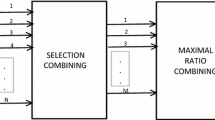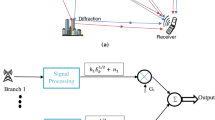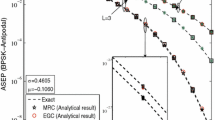Abstract
In this paper, we propose novel lower and upper bounds on the average symbol error rate (SER) of the dual-branch maximal-ratio combining and equal-gain combining diversity receivers assuming independent branches. \(M\)-ary pulse amplitude modulation and \(M\)-ary phase shift keying schemes are employed and operation over the \(\alpha -\mu \) fading channel is assumed. The proposed bounds are given in closed form and are very simple to calculate as they are composed of a double finite summation of basic functions that are readily available in the commercial software packages. Furthermore, the proposed bounds are valid for any combination of the parameters \(\alpha \) and \(\mu \) as well as \(M\). Numerical results presented show that the proposed bounds are very tight when compared to the exact SER obtained via performing the exact integrations numerically making them an attractive much simpler alternative for SER evaluation studies.






Similar content being viewed by others
Notes
It is worth mentioning here that when the channel suffers from \(\alpha -\mu \) fading, the SNR, which is proportional to the square of the fading envelope, will also be \(\alpha -\mu \) distributed but with different parameters.
It is worth mentioning that, for non-identical but independent branches, the subsequent analysis does not change much because a linear scaling on an \(\alpha -\mu \) random variable results in another \(\alpha -\mu \) random variable.
Setting \(j=K-1\) will result in a rectangle with an area of zero and hence, its corresponding term in the series vanishes. However, we prefer to retain this term to harmonize the analysis with the upper bound.
References
Yacoub, M. D. (2007). The \(\alpha -\mu \) distribution: A physical fading model for the Stacy distribution. IEEE Transactions on Vehicular Technology, 56(1), 27–34.
Magableh, A., & Matalgah, M. (2009). Moment generating function of the generalized \(\alpha -\mu \) distribution with applications. IEEE Communications Letters, 13(6), 411–413.
Magableh, A., & Matalgah, M. (2011). Channel characteristics of the generalized \(\alpha -\mu \) multipath fading model. In 7th International Wireless Communications and Mobile Computing Conference (IWCMC) (pp. 1535–1538).
Mohamed, R., Ismail, M. H., Newagy, F. A., & Mourad, H. -A. M. (2012). Capacity of the \(\alpha -\mu \) fading channel with SC diversity under adaptive transmission techniques. In 19th International Conference on Telecommunications (ICT) (pp. 1535–1538). Jounieh, Lebanon.
ElAyadi, M. M. H., & Ismail, M. H. (2012). On the cumulative distribution function of the sum and harmonic mean of two \(\alpha -\mu \) random variables with applications. IET Communications, 6(18), 3122–3130.
Da Costa, D., Yacoub, M., & Filho, J. C. S. S. (2008). Highly accurate closed-form approximations to the sum of \(\alpha -\mu \) variates and applications. IEEE Transactions on Wireless Communications, 7(9), 3301–3306.
da Costa, D. B., Yacoub, M. D., & Filho, J. (2007). Simple accurate closed-form approximations for outage probability of equal-gain and maximal-ratio receivers over \(\alpha -\mu \) (generalized Gamma) fading channels. In Proceedings of the 13th European Wireless Conference.
Yilmaz, F., & Kucur, O. (2008). Exact performance of wireless multihop transmission for M-ary coherent modulations over generalized gamma fading channels. In IEEE 19th International Symposium on Personal, Indoor and Mobile Radio Communications (PIMRC) (pp. 1–5).
Simon, M. K., & Alouini, M.-S. (2005). Digital communication over fading channels. New Jersey: Wiley.
Panic, S., Stefanovic, M., & Mosic, A. (2009). Performance analyses of selection combining diversity receiver over fading channels in the presence of co-channel interference. IET Communications, 3(11), 1769–1777.
Ismail, M., & Mohamed, R. (2013). Outage probability analysis of selection and switch-and-stay combining diversity receivers over the \(\alpha -\mu \) fading channel with co-channel interference. Wireless Personal Communications, 71(3), 2181–2195.
Stefanovic, M., Krstic, D., Anastasov, J., Panic, S., & Matovic, A. (2009). Analysis of SIR-based triple SC system over correlated \(\alpha -\mu \) fading channels. In Proceedings of the 2009 Fifth Advanced International Conference on Telecommunications, AICT ’09 (pp. 299–303). Washington, DC: IEEE Computer Society.
Aalo, V., Efthymoglou, G., Piboongungon, T., & Iskander, C. D. (2007). Performance of diversity receivers in generalised gamma fading channels. IET Communications, 1(3), 341–347.
Mathai, A., Saxena, R. K., & Haubold, H. (2010). The H function: Theory and applications. New York: Springer.
Gradshteyn, I. S., & Ryzhik, I. M. (2000). Table of integrals, series and products. San Diego: Academic Press.
Bithas, P., Sagias, N., & Mathiopoulos, P. (2007). GSC diversity receivers over generalized-gamma fading channels. IEEE Communications Letters, 11(12), 964–966.
Sagias, N., Karagiannidis, G., Mathiopoulos, P., & Tsiftsis, T. (2006). On the performance analysis of equal-gain diversity receivers over generalized gamma fading channels. IEEE Transactions on Wireless Communications, 5(10), 2967–2975.
Samimi, H., & Azmi, P. (2008). Performance analysis of equal-gain diversity receivers over generalized gamma fading channels. AEU-International Journal of Electronics and Communications, 62(7), 496–505.
Piboongungon, T., Aalo, V., & Iskander, C. D. (2005). Average error rate of linear diversity reception schemes over generalized gamma fading channels. In Proceedings of the IEEE Southeast Conference (pp. 265–270).
Abramowitz, M., & Stegun, I. A. (1972). Handbook of mathematical functions with formulas, graphs, and mathematical tables (9th ed.). New York: Dover.
Author information
Authors and Affiliations
Corresponding author
Appendices
Appendix 1: Derivation of the Derivative of the Conditional SER for \(M\)-ary PSK
In \(M\)-ary PSK modulation, it is well-known that we have \(M\) symbols whose complex baseband representations are spread evenly over a circle of radius \(\sqrt{E_s}\) separated by an angle of \(2\pi /M\) where \(E_s\) is the symbol energy. That is, the transmitted signal \(s\) can be one of \(M\) possible symbols, i.e., \(s\in \{s_0,\ldots ,s_{M-1}\}\) where \(s_i=\sqrt{E_s}\exp (2Ji\pi /M)\) and \(J=\sqrt{-1}\); see Fig. 7. At the receiver side, the received signal \(y\) is given by \(y = r s + n\) where \(n\) is the complex baseband representations of noise and \(r\) is the fading envelope. For additive white Gaussian noise (AWGN), \(n\) follows the complex Gaussian distribution, i.e., \(n\sim \mathcal {CN}(0,\sigma ^2)\) where \(\sigma ^2\) is the noise power. Given a received signal \(y\), a decision is made according to the following maximum a posteriori (MAP) rule:
where \(f(y|s=s_i)\) is the conditional density of the received signal \(y\) given that the transmitted symbol is \(s_i\) and \(P(s=s_i)\) is the a priori probability of transmitting the symbol \(s_i\). It is usually assumed that all symbols have equal a priori probabilities and hence, the term \(P(s=s_i)\) is dropped out from the last equation. Moreover, given \(r\) and \(s=s_i, y\sim \mathcal {CN}(rs_i,\sigma ^2), i=0,\ldots ,M-1\). Because of the symmetry of the \(M\)-ary PSK constellation, we can easily prove that the application of the above decision rule is equivalent to having the following decision region \(D_i\) for the symbol \(s_i\):
where \(\arg (y)\) denotes the phase angle of \(y\). An illustration for the region \(D_0\) is shown in Fig. 7. Hence, the conditional SER for \(M\)-ary PSK is given by
where the last line is derived using the fact that all symbols are equi-probable and the probabilities \(P(y\notin D_i|s=s_i), i=0,\ldots ,M-1\) are equal because of the symmetry of the \(M\)-ary PSK constellation. Defining \(y_1=\mathfrak {R}{(y)}\) and \(y_2=\mathfrak {I}{(y)}\), the following expression for the conditional SER is obtained:
Making the change of variables \(u=y_2/\sigma \) and noting that the SNR \(\zeta =r^2E_s/\sigma ^2\), we get
Differentiating the last expression with respect to \(\zeta \), we obtain
After simple algebraic manipulations, we reach the following result:
which concludes the proof of the lemma.
Appendix 2: CDF of the Sum of Two \(\alpha -\mu \) Random Variables
In order to prove Theorem 1, we write the CDF in the form of a double integral and then apply a change of variables to simplify the integrand. Afterwards, we approximate the domain of integration to another simpler domain over which the integration can be done analytically. In particular, we have
where \(f_{X_1}(x)\) and \(f_{X_2}(x)\) are given by (9). Performing the change of variables \(u=\mu _1(x_1/\hat{x}_1)^{\alpha _1}\) and \(v=\mu _2(x_2/\hat{x}_2)^{\alpha _2}\), we can easily derive that
where the region \(D\) is defined as
A sketch of the region \(D\) corresponding to \(F_{X}(x)\) is shown in Fig. 8. As expected, there is no closed-form expression for the integration in (36). However, we can approximate the region \(D\) in (37) as a set of rectangles and perform the integration in (36) over those rectangles. Depending on how the rectangles are chosen, we can obtain either a lower bound or an upper bound on the CDF as will be shown in the sequel. The partitioning of the region \(D\) is based on the fact that the curve
bounding the region \(D\), can be parameterized as \(u=\mu _1(kx/\hat{x}_1)^{\alpha _1}\) and \(v=\mu _2((1-k)x/\hat{x}_2)^{\alpha _2}\) where \(k\in [0,1]\) is the free parameter. Hence, in order to approximate the region \(D\) as rectangles, we first determine the following set of points on its bounding curve:
where \(K\) is the number of desired rectangles. Considering the set of rectangles illustrated in Fig. 9a, it is clear that the resulting CDF will represent a lower bound on the exact one. The \(j{\text {th}}\) rectangle has the vertices: \((u_j(x),0), (u_{j+1}(x),0), (u_{j+1}(x),v_{j+1}(x))\), and \((u_{j}(x),v_{j+1}(x))\) Footnote 3. Performing the integration over these rectangles, \(F_{X}(x)\) is found to be lower bounded by the finite series \(L_s(x;K)\) given by
where \(u_j(x)\) and \(v_j(x)\) are given by (39). The \(j{\text {th}}\)-term in the series in (15) is the value of the integration of the integrand in (36) over the \(j{\text {th}}\) rectangle. Similarly, if the rectangles are chosen as illustrated in Fig. 9b, an upper bound will then be obtained. The \(j{\text {th}}\) rectangle of the upper-bound approximation has the vertices: \((u_j(x),0), (u_{j+1}(x),0), (u_{j+1}(x),v_{j}(x))\), and \((u_{j}(x),v_{j}(x))\). Consequently, \(F_{X}(x)\) is found to be upper bounded by \(U_s(x;K)\), given by
Hence, the exact CDF \(F_{X}(x)\) is lower and upper bounded as
This completes the proof of the first part of Theorem 1. The proof of uniform convergence is provided in [5].
Rights and permissions
About this article
Cite this article
El Ayadi, M.M.H., Ismail, M.H. Novel Tight Closed-Form Bounds for the Symbol Error Rate of EGC and MRC Diversity Receivers Employing Linear Modulations Over \(\alpha -\mu \) Fading. Wireless Pers Commun 77, 571–587 (2014). https://doi.org/10.1007/s11277-013-1523-z
Published:
Issue Date:
DOI: https://doi.org/10.1007/s11277-013-1523-z







